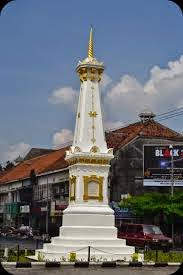TUGU MANGKUBUMI
Tugu MANGKUBUMI(white pole) is a marker of the northern boundary of the old city of Yogyakarta. Originally, the building is shaped like a round stick (gilig) with a ball (golong) above. In 1867 the building was damaged (broken) because of the earthquake which also damaged Taman Sari . In the reign of Sultan HB VII of the building is re-established. But unfortunately with different shapes as can be seen now (January 2008). The height was reduced and only a third of the height of the original building. Over time the name of the monument Golong Gilig increasingly forgotten as the mention of this building as the Tugu Yogyakarta.
BANGSAL KENCONO
Bangsal Kencono Sultan Palace is a traditional house-shaped pavilion. Kraton is home to the king or queen. This palace has a meaning and philosophy. Philosophy of life of a human nature, human nature works and live their lives, as well as various symbols of life in them. At the front there are two Arca Gupolo stone statue, which is sort of a giant bat-shaped holding a mace.
BUSANA DODOTAN
Overall a set of traditional clothing worn men Yogyakarta consists of headgear or blangkon, surjan, batik or jarik and slopen.
While clothing usually worn by women kebaya hairdo chignon or round shaped. Cloth material used to manufacture clothing yogyakarta among others derived from cotton, silk, linen sunduri, nylon, striated, or aesthetic materials. Manufacturing techniques there are woven, knitted, batik, and dyed. As for his own kebaya mostly using velvet, brocade, or silk.
KERIS LADRANG
Keris Ladrang is a dagger weapon class (pointy and sharp-pointed on both sides) with many cultural functions are known in the western and central archipelago. The shape is distinctive and easily distinguished from other sharp weapons because it is not symmetrical at the base of the dilated, often winding blade, and many of them have the pamor, namely the visible fibers of a bright metallic finish on slats strands. Type of stabbing weapon that has similarities with the dagger is the dagger and kerambit.
Local languages are spoken dialect of Javanese people of Yogya usually abbreviate words, or sentences that add to steady and pleasant.





